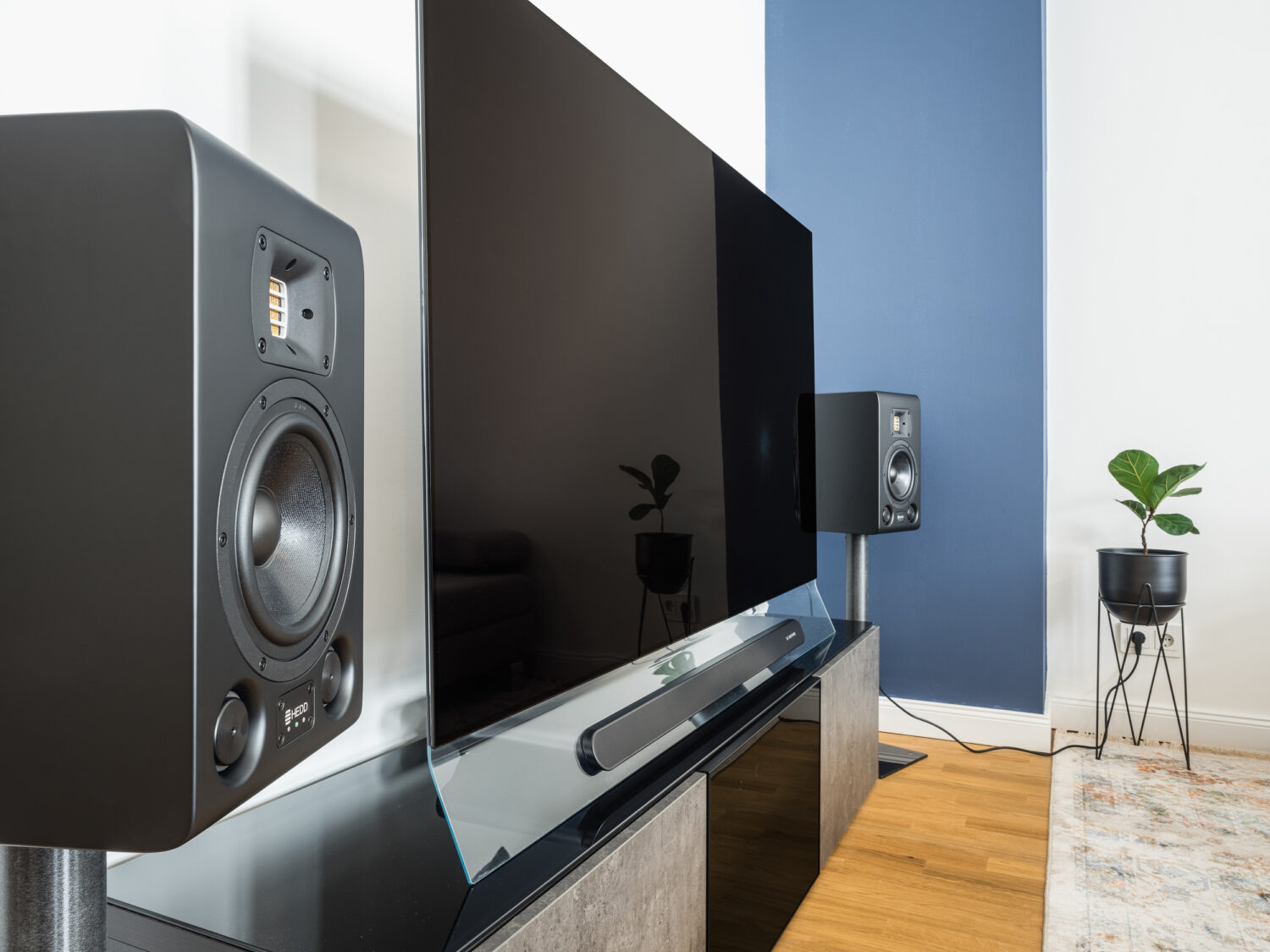
Full disclaimer first: I work for the smart people at HEDD Audio! I’m fairly new to the company so I have absolutely zero involvement in any of the company’s current products. Since I’m not an engineer, technician, or physicist, my feedback will also probably have little relevance for future products. So ultimately I am still an audiophile-first who is currently learning a lot about pro-audio. I am only here to share my passion. Read more here.
Visit the HEDD Audio homepage at HEDD.Audio.
Quick Navigation
Introduction
Having been able to listen to the various HEDD speakers at HEDD’s R&D room, I thought it would be time to try a set of the acclaimed studio monitors out at home. I am replacing a pair of Yamaha NS-555 stereo speakers, which – at least at the time – were considered to be fairly neutral for home listening. Compared to the Type 07 MK2, they shouldn’t be far off according to the spec sheet: 3-way with 5” and dual 7” woofers, 30 Hz – 35 kHz frequency response. These passive hifi speakers are amped by an Audiolab A6000.
First Impressions
What I noticed immediately is the very high resolution and clarity from the Type 07 MK2. At first listen, details – especially in voices – are much easier to pick up. Yet the tonality does not seem bright or colored at all. Furthermore, the treble is very smooth without omitting details. The Bass comes through very clean and I was surprised that the small Type 07 MK2 actually had stronger bass than the Yamaha floor speakers. I am not lying, just a few tracks in, both my wife and I had tears in our eyes.
Features
The HEDD Type MK2 monitors have a huge feature set. There are a total of 9 knobs to play with on the back panel. I’m not covering most of them. If you are interested in all the options, though, have a look at the official manual: https://hedd.audio/wp-content/uploads/HEDD-Type-05-07-Manual.pdf
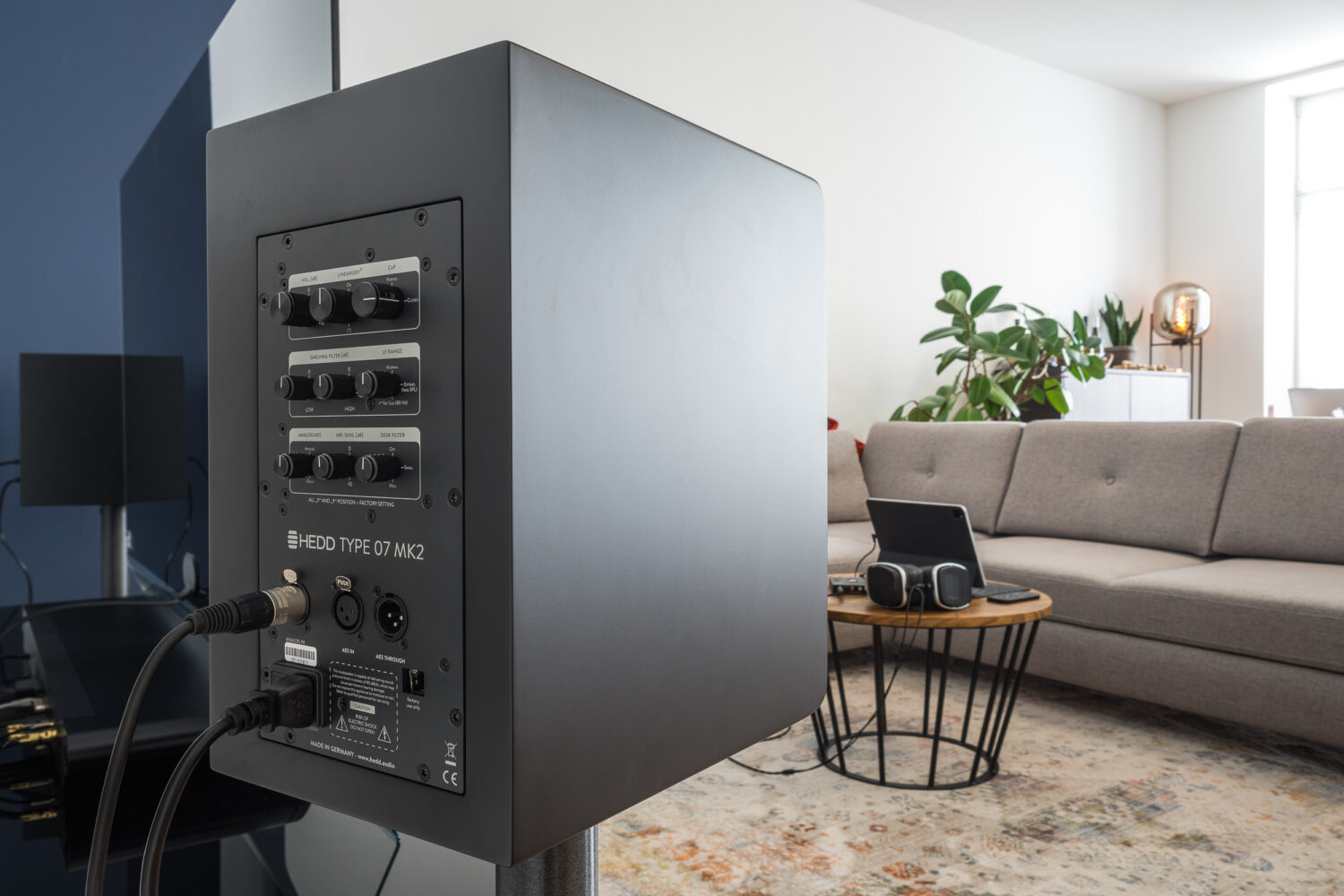
«CoP»: Closed or Ported
The soundstage is bigger and wider in Ported mode, but once adjusted to Closed mode, the preference for the Closed mode seems far less like a trade-off. Clarity boosts considerably and, in my opinion, the bass is not one bit lacking. On the contrary, I found the bass to be snappier and have even better punch and texture. I did not notice any lack in quantity or less extension, to be honest.
Switching back to Ported mode, I had a hard time enjoying strings as much as I did in Closed mode. Also, voices seem to have less contour and were more difficult to place in the soundstage. In my opinion, everything comes better together in Closed mode, and, ultimately, this setting is more realistic to my ears.
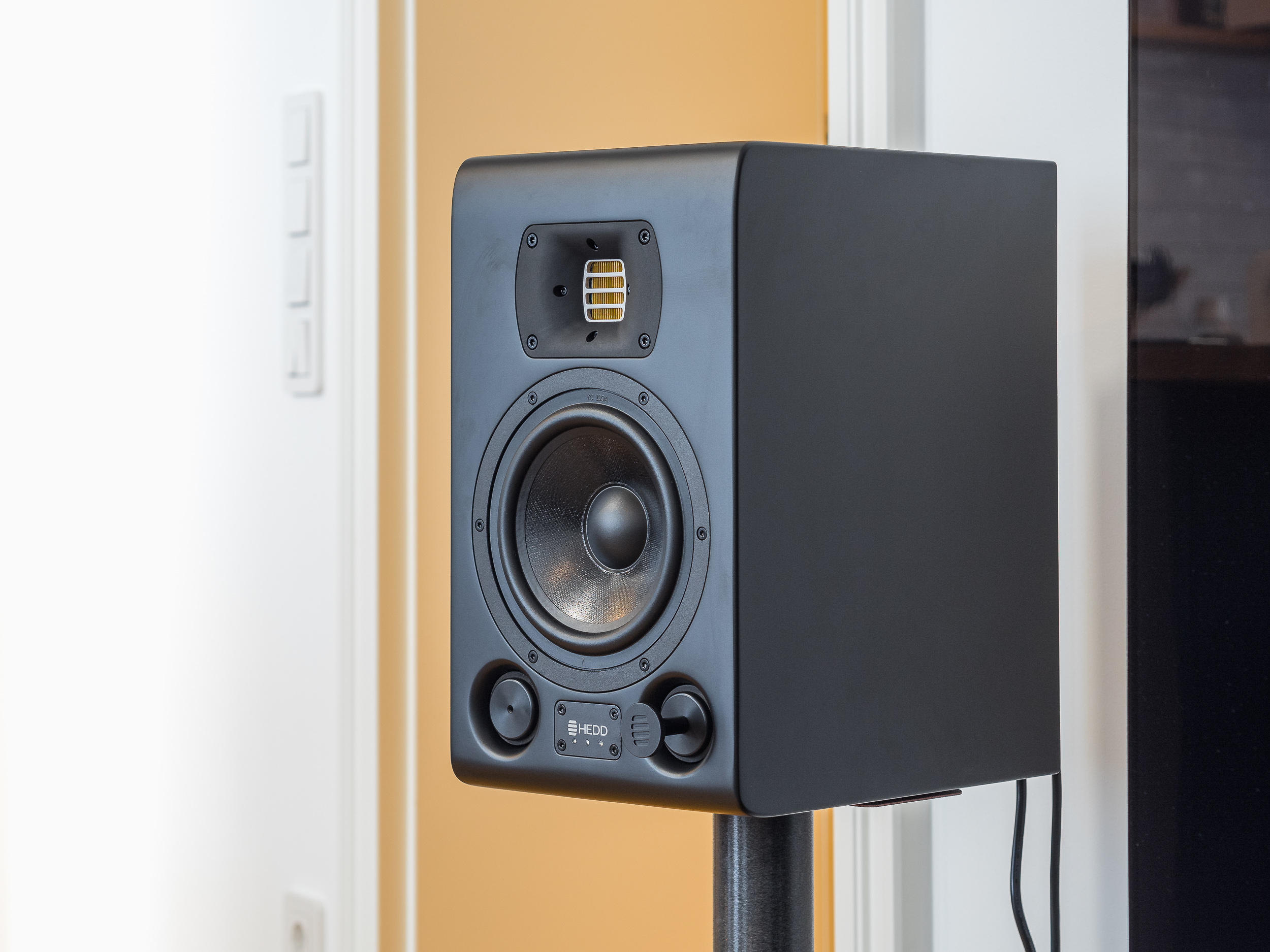
On-Board HEDD Lineariser®
The Lineariser Is Not an EQ
Do not mistake the HEDD Lineariser® with an equalizer! Usually, when people speak of linear sound, they mean that the sound pressure across any two frequencies is the same. The HEDD studio monitors are designed to do that anyway. With HEDD’s switch to a high-end DSP, the MK2 speakers now have such a correction integrated, though the previous MK1 was very close already. This cannot be deactivated and only changed by adjusting the shelving filters on the back panel. Linearity in regards to frequency response is a given! Instead, the Lineariser goes one step further and fixes inevitable errors in the frequency-time domain that are created from any conventional driver. These phase shifts also have effects on the amplitude, so in a way, the Lineariser does also act as a final touch to an EQ, but its main purpose is different.
Phase-Lineariser
The HEDD Lineariser is a full-range phase-correction. In effect, vibrations can have different movement patterns when playing the same frequencies. But there is only one right way for them to move – and that is in-phase. Movement speed is the same, but differences in amplitude may occur and the spatial information might be diffuse when swung out of phase. I’ll probably dive into this topic in another article. The verdict is that I recommend leaving this function activated.
During the development phase, I had a chance to participate in a blind A/B test and with most tracks, I had no difficulties detecting the linearised speaker. My impressions matched those of the other participants, which were a wider soundstage, cleaner spatial separation, and more precise imaging. The overall tonality remains unchanged! This test is more difficult to replicate at home, having to stand up, moving to speaker A, rotating the knob, going over to speaker B and doing the same, then going back to the seat.
Deactivating the Lineariser
There is an option to deactivate the Lineariser because it creates a short delay of ca. 10-14ms. Listening to music, it’s completely irrelevant. It’s also not noticeable when watching TV. I am not sure about the video processing of our LG OLED, but there is also a video delay there, so it seems to sync up well enough. I haven’t noticed any difference in the passive setup from before. If you want to use the speakers for 1:1 live monitoring, maybe it makes a difference. This would probably be more relevant for broadcasting speakers and less so for studio monitors in mixing and mastering. Even less so for music consumption.
Integrated Limiter
To set the mood for the weekend, I tried to push the volume above my usual listening levels. My RME still had plenty of headroom and I haven’t even touched the input sensitivity controls of the speakers. In Closed mode and activated LFE, I noticed the red light next to the power LED flash. This signals an overload and a limiter kicks in to prevent the drivers from moving above their comfort zone. At the level I was playing, the red light only flashed occasionally for short periods which did not have any audible effects. Be informed that if you plan to throw a house party, you best either add a subwoofer or upgrade to Type 20 MK2. For me, this is no concern. If I really wanted to annoy my neighbors, I’d deactivate LFE and switch to Ported mode.
Sound
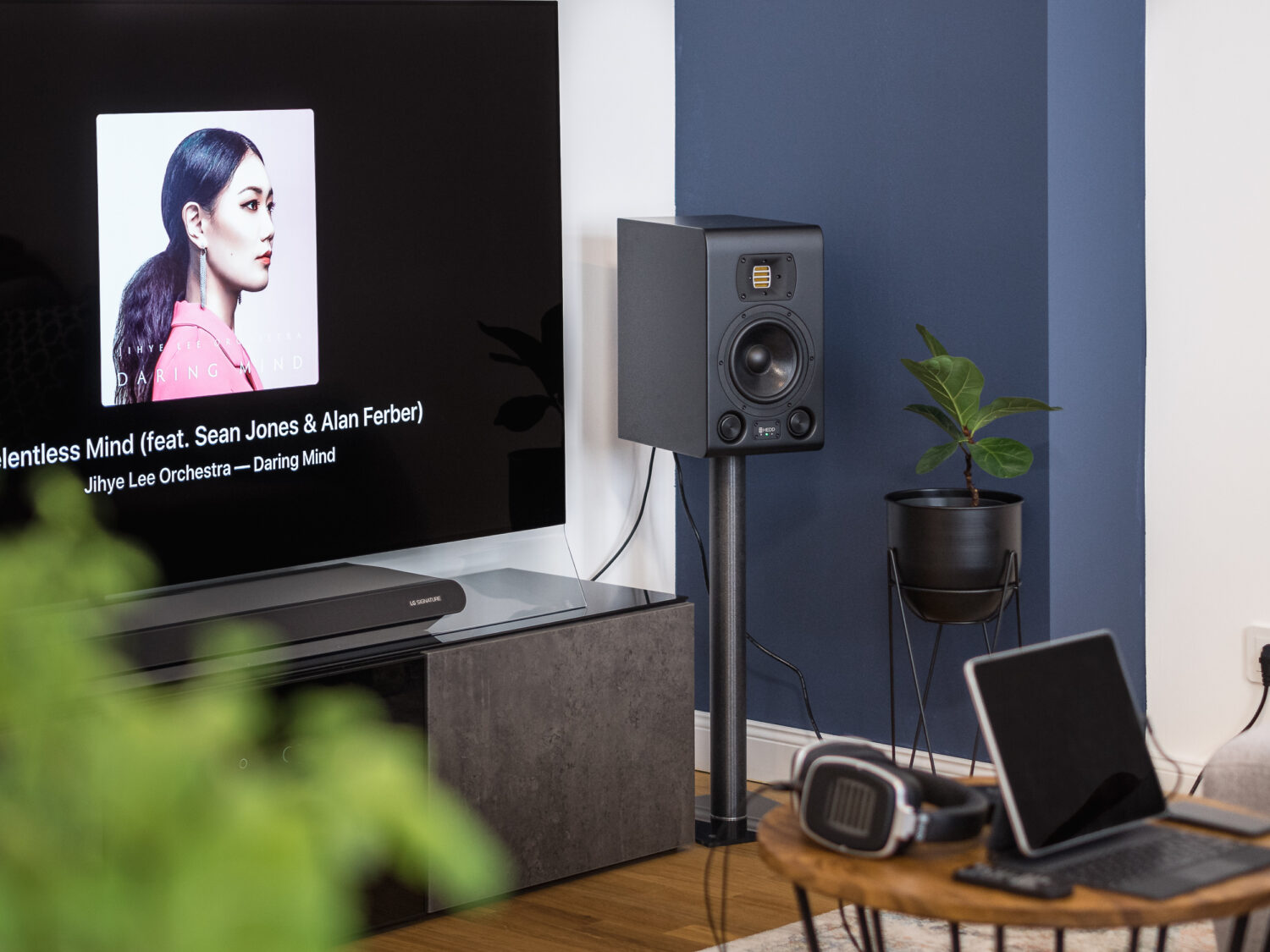
These are basically audiophile sound impressions. They are subjective! I’ve always been interested in high-fidelity as a science, e.g. logical approach, but in the end, I do not have the experience of an audio engineer and I have never mixed or mastered tracks on my own. What I did notice, though, is that my impressions usually match those of more educated users. Regardless of whether it’s speakers, headphones, or IEM.
My source is my trusted RME ADI-2 DAC, hand-picked by the designer himself and with small variances that make this unit perform slightly better than the data in the spec sheet. I was also using this device as a pre-amp for the Audiolab A6000. Now I have connected the Type 07 MK2 via XLR and made sure all settings were reverted. On the monitors, Lineariser is activated and «CoP» is set to Closed.
Tuning
Huh, it’s neutral. What’s more to say?
Don’t believe me? I have proof! These speakers were measured in an anechoic chamber and designed to be ruler-flat. The usual tolerance of ±3 dB is considerably lowered through the integrated DSP and even more so through the Lineariser. How would I even dare to claim otherwise and challenge mathematics?

Studio Near-Field vs Home Stereo
Of course, there is always some way of describing the tonality. I have listened to quite a few “hifi” speakers too. In comparison, a neutral studio monitor has a more forward midrange, less boom in the bass, and a less articulate treble. In my experience, the midrange of speakers that are advertised for audiophiles cut down mid details or boost fundamentals for a fuller sound. Most obviously, hifi speakers try to impress with deep and voluminous bass. Then they elevate high frequencies to create sparkle. This contrast is often described as “having a dynamic sound” as the SPL level moves a lot depending on the information at the extreme ends. It’s basically the same in photo editing where boosted blacks and whites create a stronger contrast and a more punchy image, yet drowns finer details and overshadows nuances.
Room Influence
Fortunately, near-field speakers like the Type 07 MK2 are designed to reduce the influence of the room. Of course, there is no way to completely prevent resonances, reflections, or room modes. Especially in my case, I have placed the speakers in a poorly-treated room. We have an open kitchen that’s connected to the living room. One speaker is placed relatively close to a corner. Moreso, we currently have a heavy slate table in front of the couch. I can mitigate its influence through the use of Desk Filters that I can access via the rear settings. At first, I thought studio monitors would be more dependent on the room, but it turns out they are less so. Of course, they need to be placed in a stereo triangle.
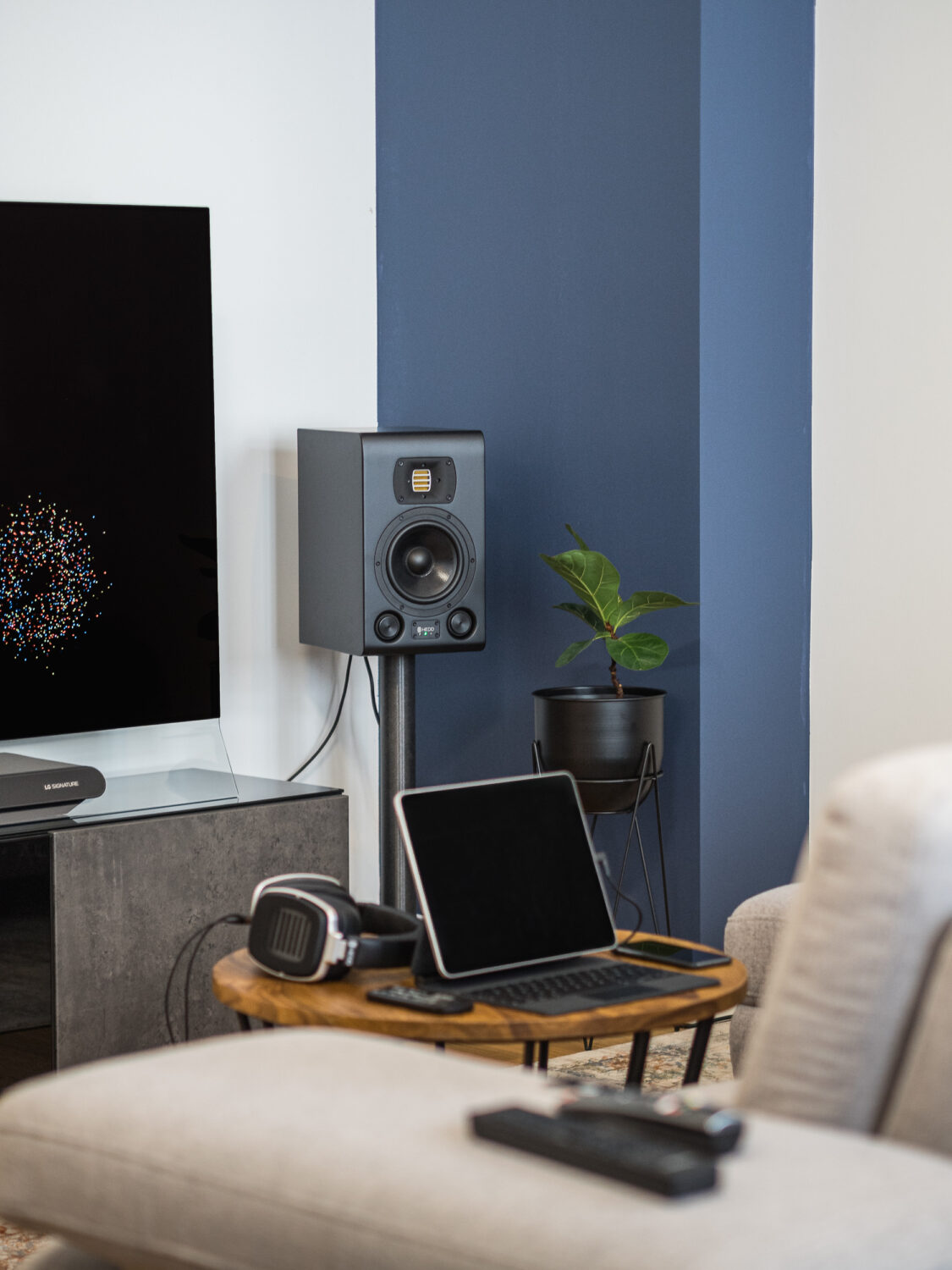
Bass
I am very impressed by the bass quality. Prior, I had only heard these speakers in the R&D room where they were challenged by HEDD’s larger speakers and also optionally connected to a subwoofer. But set up at home at my preferred listening volume, the bass quantity and quality are not lacking one bit. Ported mode would allow the bass to have more presence, but perhaps depending on my room and placement, I would say the Ported mode was actually too strong. Closed mode is exactly where I want the bass to be. You can still feel the vibration but there is no annoying boom.
In Closed mode, the bass texture is wonderful and is a joy with Classical pieces that include cellos. The punch with Pop music is just as great. It manages to create impact from speed alone without elevating the presence.
My Yammies performance is ridiculous in comparison. There is almost no physical impact at all, the low-end just fills the room in a cloud of warmth and thickness. The low-end extension is not even close, despite the spec sheet claiming otherwise. The NS-555 sound much warmer with a fuller and thick-sounding mid-bass.
Low Frequency Extension
There is an option to increase the frequency range of the 07 and improve the low-end extension via the LF RANGE setting. If activated, the -3dB threshold of the Type 07 MK2 shifts from 38 Hz to 30 Hz. That is plenty low. Do note that the driver has to “work harder” for this, so the limiter will kick in earlier. The maximum output level is thus lower. However, this was not a problem in my use. Nonetheless, I mostly kept the LFE deactivated because I did not have the impression that going 8 Hz lower added anything substantial to the sound and I’d rather preserve the headroom.
Midrange
The midrange is incredibly revealing with a life-like rendition of instruments and voices. Many headphones fail to re-create this level of realism and I now start to understand why pro-audio is concentrated around near-fields. The mids are forward without creating fatigue. The Type 07 MK2 unfold multiple layers of the mixing process and will definitely help in the mixing process to prevent mistakes.
This level of transparency is rarely heard from IEM and is thus almost new to me. I’m curious how many studio monitors actually nail the midrange like I am hearing it here. The same goes for my previous towers. They just create mud and blur when playing the same tracks. Moreso, the voices are not as present and I often have problems understanding what people say in movies. I don’t have this problem with the Type 07.
Treble
The high frequencies are a great deal for HEDD. As founder of ADAM Audio, Klaus Heinz basically made the air motion transformer (AMT) a success as a tweeter. The HEDD AMT is the experience, knowledge, and refinement of over 20 years of development. I have not heard any of his previous ADAM monitors, but people are telling me the HEDD version is the most natural-sounding of them all.
Though I’m not the one to confirm this claim, I can definitely tell the AMT sounds as transparent as anything. Moreover, the treble is not forward but I’d describe it as relaxed and laid back, effortlessly replicating harmonics of violins and cymbal splashes. I have definitely come across far sharper-sounding high-end speakers over the years.
You’d expect that a tweeter, which is said to extend to 40 or even 50 kHz, to use far more presence to reach that extension. But I can safely say that this is not the case here. Vocals remain positioned in the front and there is no articulation of s-sounds or otherwise definition in the highs. However, the AMT probably helps to span that large soundstage. The Yamaha speakers have stronger treble but are in no way as detailed. Violins do sound great coming from the Yamaha, but especially cymbals lack definition and snap.
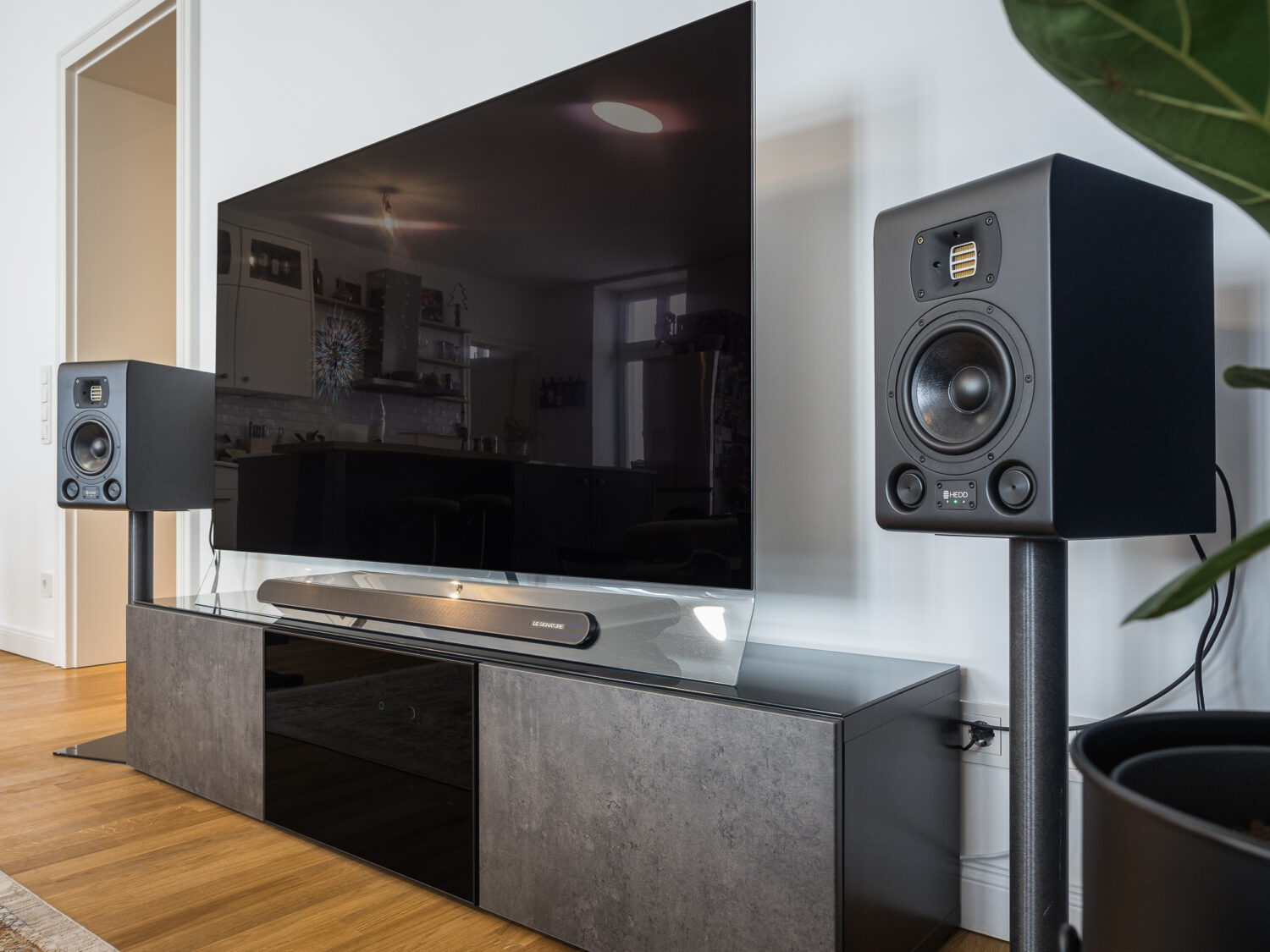
Verdict of an Audiophile
Damn, these sound good! I am convinced, even for home stereo applications, the near-field Type 07 MK2 are incredible and I’d gladly throw out any similarly priced passive speaker to make room for them. The integrated DSP has actual audible benefits over the previous generation, instead of merely fixing the laziness of lesser ambitious designers or reducing material and R&D costs.
I love the Closed mode! For me, Ported is not even an option anymore. The speed and transient attack are really refreshing and sound much more realistic to me. It’s a huge step up to the speakers I used before. The Lineariser is more nuanced and, IMO, it is difficult to tell without a reference. I am happy I could do a blind test and hear the improvements clearly. Having the Lineariser activated is basically knowing that one is one step closer to perfection.
At no time did I miss a subwoofer. The bass goes low, has a sufficient amount of rumble, and most importantly never clouds any of the other frequencies. The punch in Closed mode is as incredible and addictive as I ever experienced. Unsurprisingly, the midrange shines most with exemplary clarity and accuracy. The trademark AMT from Klaus Heinz is well integrated and is not trying to draw attention to the high frequencies at all. Instead, it helps to recreate realistic harmonics and ties the whole presentation together. Soundstage is very impressive with razor-sharp imaging and instrument placement. Though designed for monitoring (production, mixing, mastering), the audiophile appeal is huge – from the sound alone, I would not ask more of a speaker for music listening.
Are they Suitable for Home HiFi Use?

Unfortunately, I do not have the feeling that the Type 07 MK2 was designed to be placed at my home. Starting with the looks, the satin black cabinet doesn’t harmonize with a black reflective television or monitor as the piano black Yamahas did. As impressive as the AMT is, it’s not presented in a premium way. The grey protective grill would have to be chrome for that. Furthermore, the screws around the waveguide and woofer have a distinctly industrial look that can feel out of place in a living room. All the functions and especially the power switch on the rear are difficult to access. As a consumer, I am spoilt from the comfort of remote controls. And that’s not all, without another pro-audio device like the RME, the connectivity is basically useless for home applications – XLR and AES only, no Cinch and no SPDIF!
Yet I have to say the trade-offs are worth it. My audiophile heart is pounding! Would I appreciate more flashy looks? Definitely. But usually, this also means boomy bass, dull mids, and artificial treble. For me, sound matters more!
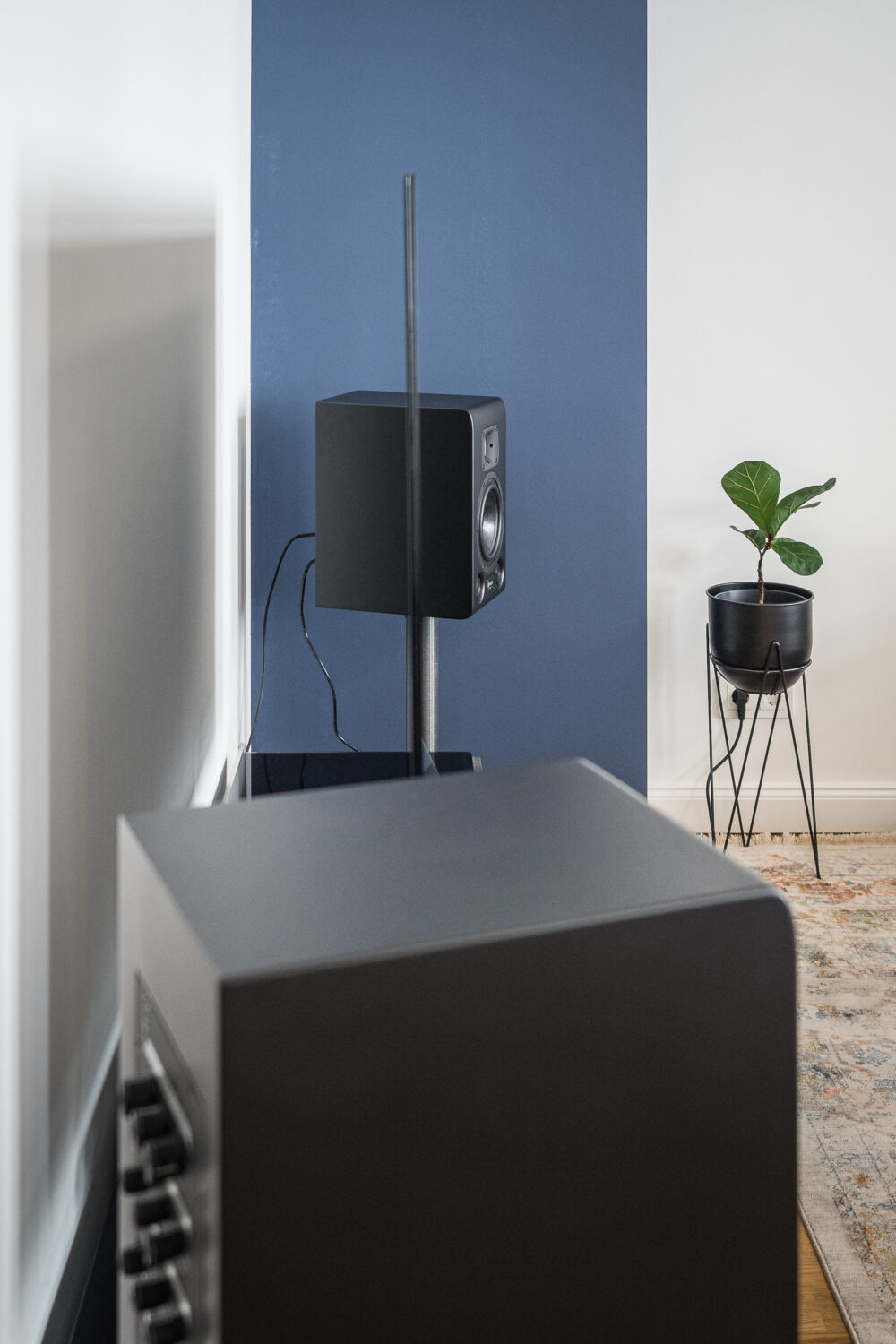
Do you like my photos? Follow me on Instagram.

Thank you, Klaus, for this hands-on review of a studio monitor in your home setting. I am currently debating between a pair of Hedd 07 and 05 MK2 speakers for my near field listening setup at home. I have already purchased a Hedd Bass 08 sub to go with them. My current setup is Audioengine A-5 speakers in solid bamboo on desk stands plus an 8″ Energy ES-8 sub (from many years ago) with a Topping DX-3 Pro DAC/pre as source from my iMac files plus Apple Music HD. I really enjoy this system now and am looking to upgrade it substantially. I looked hard at active speakers from KEF, Dynaudio, Elac Navis, Neumann, Genelac, and Focal and decided that Hedd is the way to go, and your review helps cement that decision for me. Not for the esthetics, as you clearly mention, but for the SOUND quality and the VALUE. A decisive factor for me was the review by Gordon Brockhouse (SoundStage Simplifi) of the Hedd sub/sat system with the 05 MK2 and Bass 08, along with his reviews of many of the other speakers I was considering. I will be also purchasing an RME ADI-2 fs as my new DAC/pre to drive them.
My main surround system in the living room is Paradigm Signature BE speakers, Anthem amplification, and JL Audio sub – and now with Atmos height speakers. A massive, expensive, and very complicated system that my wife is unable to operate (also Apple TV HD, streaming, LG OLED tv, Panasonic Blu-Ray/CD, etc) on her own. Long term I plan to also “Simplifi” this system and make it less complex and much easier to use. Thanks again for your review.
Hello,
This is a very nice and good review. John Darko brought these speakers to my attention. I’m currently an owner of a pair Kef LS50 W/XTZ 10.16 Edge subwoofer. I’m using a MiniDSP for room correction. I wonder how the Kefs will stand against these monitors, as the Kef are “pure” hifi speakers and known for there detailed highs and mids with pinpointed image?
Regards,
Johan
Hi Johan,
I was wondering as well how the KEF would compare. So I just had to find out 😉
https://www.klauseulenbach.de/2021/11/01/kef-ls50/
Indeed thanks for the review. I am – or should I say was – considering the Elac Navis ARB-51 and the Kef LS50 Meta/Wireless II. Now the Hedd Type 07 mk2 is high on my wish list, also brought to my attention by a review of John Darko.
Next to the choice of speakers, with matching sub, I need to decide on the source being a RMA ADI 2 FS DAC or a Cambridge Audio CXN V2. The last having the advantage of being a Pr-Amp/Streamer DAC.
Would like to know which you all would choose and why. Yanks again for the very useful review.
Hi, nice review. Thouse monitors look good, I only miss volume control. With xlrvinout I can use volume on my m-dac, but with digital input volume must be lowered in digital domain only ?? It’s pitty, I prefer possibility to limit max SPL of monitors to preserve audio quality and for safety reasons (to avoid get max volume accidentally).
Hello Klaus,
excellent review. I am currently in the process of deciding on new monitors which are also suitable as HiFi Speakers in small rooms. Of course, Hedd 07 MK2 or eventually even the type 05 strucked me and they are definitely in my short list. KEF i ruled out since i didn’t like the setting because they don’t suit my preferred music style, namely electronic and metal (you also mentioned something similar in your KEF review). I also ruled out Neumann KH120 because they are absolutely brilliant for studio purpose, a bit less so for HiFi usage in small rooms. So, right now i am left with the choice between Hedd and Nuberts Nupro XS-4000. What speaks for the Nupro is the vast options of connectivity and they are certainly suitable as HiFi Speakers in small rooms. What i didn’t like, although they go as low as 38Hz or so, in the bass area they don’t sound as precise as the Hedd (based on sound examples i had), the bass wasn’t as snappy and punctual as from the Hedd. And in CoP the Hedd is super precise. I will use the speaker 100% for music only, not for home cinema purpose, so extreme low frequency capabilities are rather irrelevant anyways.
How would you compare the Nuberts to the Hedd speaker? Have you had any experience?